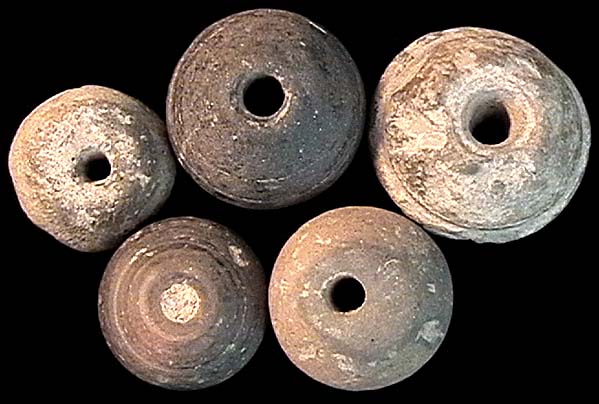A few months ago, I bought a great little kit from my lamp work suppliers for sandblasting. It was sold for working with glass, but I wanted to try it with ceramic. I’ve had an idea in mind for a range of relic beads. Beads that look like they’ve been lying in the ground for years and been recently discovered by archaeologists. Beads like these!
GREEK-SCYTHIAN, c. 300-100 BC, lot of 1 stone & 4 clay beads, 18-24mm dia., from Bazera
This is the kit. You get a blow up sandblasting booth, a compressor and hosing, and an airbrush type gun. To create the weathered look, you use the abrasive powder, (also supplied in the kit) to blast the glaze from your work.
For safety, you also get a dust mask. This is a messy process with the abrasive powder ending up everywhere, so it’s an outside job!
I’m still at the experimenting stage with all this, but so far, I’m loving the effects I can get.
This Goddess bead was made from earthenware clay and fired with a variegated green glaze. She was the refired with 24 carat gold lustre before going in to the booth for blasting. The majority of the gold was removed during the process, but you can see hints of it in the deep crevices giving her a worn appearance.
I really like that with the softer earthenware clay, you can blast right through the surface to the clay below exposing the bare material. You can half imagine that these scuffs have appeared from years of being worn as an amulet around an ancient warrior queens neck as she went in to battle! I’m looking forward to making more of these and trying out some different designs!
These next beads were glazed in matt turquoise and shades of blue before being blasted in the booth. Again, you can see the porous clay beneath. These could have been lost at sea, being tumbled by the waves over centuries before finally washing up on the beach!
For my next experiment, I tried working with porcelain clay. This is much harder to blast, just getting through the glaze takes a good 10 minutes of work, so I decided to try a more etched effect. I made some hollow porcelain lentils and created a digital design of a dreamcatcher, which I then cut in vinyl to create a resist for the sandblasting. The vinyl stickers were placed on the glazed bead and then went in to the booth. The blasting created a much softer effect and etched where the glaze was exposed, leaving the design shiny. The lentils were teamed up with some porcelain feathers to make dreamcatcher sets.
With orders and preparing for shows, I haven’t had as much time as I’d like to explore more of the effects I can get with this technique, but I’m really enjoying experimenting, and am excited to see where this takes my work! I hope you enjoyed reading along!
Caroline







Wow these are really beautiful, I love the effect you have managed to acheave on godess bead and those dream catchers are great!
ReplyDeleteI wAs wondering how you'd done the dream catchers...I knew the cameo came into it but hadn't quitesussedthe rest! They look great- I thong you're onto a winner here.
ReplyDeleteI thong....head full of cold - sorry!
ReplyDeleteAwesome Caroline, I love the look of it. That Goddess is amazing!!! Makes the head spin with possibilities!!
ReplyDeleteI actually have a sandblaster, but like most of the tools I have it has gone unused for beads. This definitely makes me want to play with it. Of course, the time required to play around isn't there! You got fabulous results!
ReplyDeletethey look gorgeous - like antiques
ReplyDeleteAmazing! Your goddess bead looks ancient! Wonderful effect. LOVE the etched dreamcatcher lentils, VERY cool.
ReplyDeleteWow! You have definitely achieved an aged effect. I just love the goddess bead and those dream catchers are to die for.
ReplyDeleteOh my goodness that is sooo cool and I love the little booth that you get!
ReplyDeleteThese look great! What a fab bit of kit :D
ReplyDeleteThis is so cool and such an original approach. I love the contrast between the shiny and the matte finishes on the dream catcher beads.
ReplyDeleteThanks all! This is why I love working in an experimental way, sometimes things work out just as you expected! (other times they get hidden at the back of the garage!) Glad you enjoyed my post and if you ever get the chance to have a try, I would highly recommend it!
ReplyDeleteI really love all these, but especially the dreamcatcher beads. WOW!
ReplyDeleteCan you share where you got your sandblasting set-up? I do fused glass and would love to try sandblasting some of my pieces.
ReplyDeleteI never would have thought to sandblast ceramics. I know that a lost of sandblasting can be used for construction. I guess it has so many uses.
ReplyDeleteElisa Jed | http://www.blastpro.com.au
Sandblasting is a nice technique. I love the rustic patterns. It can really help it stand out. http://www.blastpro.com.au
ReplyDelete